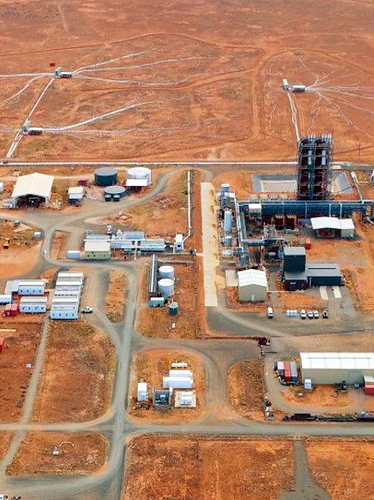Uranium production will resume by the end of next year at the Honeymoon uranium mine in north-east South Australia, the owner says.
Key points:
- The Honeymoon uranium mine has been mothballed since 2013
- Uranium prices have increased recently
- Owner Boss Energy says it will produce 2.5 million tonnes of uranium annually by 2026
Boss Energy announced this morning that it had signed off on a $113 million upgrade of the mine near Broken Hill, after previous plans to revive the mine were shelved in 2013 because of low uranium prices and high production costs.
Production is expected to begin by December next year, with the outback mine forecast to produce 2.5 million pounds of uranium per year by 2026.
In a statement to the ASX, Boss Energy said it had raised capital for the project through $125 million in share sales in March.
The company’s managing director, Duncan Craib, and director Bryn Jones briefed South Australian Mining Minister Tom Koutsantonis on the project on Friday.
Uranium prices have almost doubled since the start of 2021, to more than $55 per pound today.
“This final investment decision puts Boss firmly on track to be Australia’s next uranium producer,” Mr Craib said.
“We are fully funded with no debt, fully permitted and (have) extensive infrastructure in place.
“Our front-end engineering studies are completed and we are ready to order key equipment and start construction immediately.
“This puts us in an extremely strong negotiating position with utilities and ensures we can capitalise on the looming uranium supply deficit.”
Long history of ups and downs
The Honeymoon deposit was discovered in 1972.
Construction on the mine began in 2009 and production began in 2011, under the company Uranium One.
The mine has been mothballed since 2013.
Boss Resources bought Uranium One in 2015 and changed its name to Boss Energy in 2020.
There are three other uranium mines in South Australia, including the world’s second largest by production, at Olympic Dam.
Mr Craib said there was room for expansion in Australia’s uranium mining industry.
“Last year, we exported about 6,000 tonnes of uranium. That’s enough to provide for 75 per cent of Australia’s national energy market with zero emissions.
“Even allowing for a four-fold increase in exports, we could meet the UK and France’s total electricity needs for the next 60 years.”
The project site was the subject of protests in the 1980s because of concerns about nuclear proliferation and waste, as well as native title rights.
Detractors now oppose it because of a preference for renewable energy over nuclear power.
Posted , updated




